1913
Facts: Most models distinguishable from 1912 because of
control levers now moved inside body; engine Nos. 75002 - 90018; 1st one built 29.5.1912,
kept as factory car, 1st car to dealer was No. 75005 Touring car, last one still lives
(LaRue Thomas collection, Los Angeles Cadillac dealership), other "firsts"
mentioned in CLCA 1973; open bodies were steel, closed ones were aluminum; before
1.11.1912, all had Baker demountable rims (about 2000 cars), later ones from 1.1.1912 -
10.5.1913 had similar rims by Kelsey, balance had Kelsey Quick-Demountable rims;
specifications: 4-cylinder engine, 4½x5¾" bore and stroke (114,3x146,5mm), longest
ever Cadillac stroke, 48.7 HP, (NACC 32.4HP), offset crank (since car's inception in
1902), back to 5 bearings, 2nd year of self-starter, solid brass carburetor with only one
adjustment, gear ratio touring cars, phaeton, torpedo and coupe 3.43-1 (optional 3.66-1),
roadster 3.05-1 (optional 3.43-1), limousine 3.66 to 1 (optional 3.92 to 1), wheel base up
4" (10.16cms) to 120" (304.8cms), all tires up to 36x4½" (91.44x11.43cms),
tread unchanged 56" (142.24cms) (option 61" 154.94cms), steering wheel diameter
unchanged at 18" (45.72cms); gasoline capacity: 20-gallons for the touring car, the
torpedo and the limousine, 14-gallons (for the phaeton, the roadster and the coupe (the
tank was located under the front seat); story and photos (CLCA 1973, pp.12-17);
standard color for open cars plus limousine and coupe was Cadillac blue body and chassis;
with striping; doors, wheels with black upper body & moldings; torpedo optionally
available in steel gray with black moldings, black hood and fenders; special colors on
request, e.g. yellow, green, black, purple and red, nickel-plated bright trim (only some
brass parts in motor); some engine/ chassis sold with no body; for other standard
equipment, accessories, prices, see (CLCA 1973 p.13); 1913 brochure states that "The
artistic body designs which characterize Cadillac cars are made possible by a unique
system of designing and manufacture" (details are given); wheels 36x4½"
(91.44x11.43cms); battery now 130 a/h (located on running board), change to Warner
speedometer, tops made by Cadillac have bows of best selected ash, leather straps in front
hold tops securely in place; all tops include side-curtains (lighted with transparent
material) and dust hood (top boot) in same material as seat slip covers (if latter were
ordered).
Easy ID: All controls now inside body (e.g. brake lever,
gear lever, bulb horn); fully curved fenders front and rear, except roadster [still
relatively flat leading down to running boards]; coupe similar to 1912 except for new
position of side lights; limousine returns to open front configuration with half-windows
offering some protection at rear of compartment; stanchions for electric side lamps on
coupe and limousine now lower (almost level with fold of hood) thus placing top of lamps
level with top of hood.
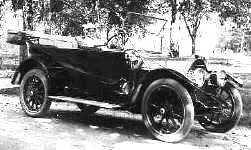
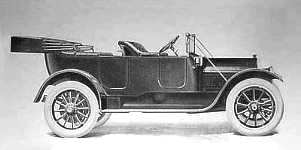
Models: "1913" Models made of metal over wood
frames [except coupe and limousine that had aluminum bodies] (1) 5-passenger
standard Touring Car without jump seats, with new curved cowl, slightly shorter
than 6-passenger car, 3760lbs, 21 gallons ($1975); article (CLCA 1980, p.35); (2)
6-passenger Touring car with two folding auxiliary seats, 3900 lbs., 21 gall.,
($2075); (3) 4-passenger Torpedo, 21 gallons gas, 3769 lbs. ($1975); (4)
4-passenger Phaeton, 3760lbs., 17 gall., with raised rib 3" (7.62cms) below belt line
and metal trunk portion in rear ($1975); (5) Roadster 3475lbs, 17 gallons
gas ($1975); (6) aluminum-bodied Limousine, 4150lbs., 21 gall., back to ¾
enclosed front compartment with storm curtains provided for open driver portion, French
roll across front of driver's seat, stationary lower windshield, swing-out top portion;
rear compartment including 2 folding and revolving auxiliary seats (folding up close to
body sides when not in use), over-stuffed front of seat in French style, rosewood lever
lock handles, edge of slip pockets bound in narrow lace, doors open at 100° angle, fitted
with French head hinges, concealed knuckles and improved Yale locks ($3250); (7)
4-passenger aluminum Coupe, 3760lbs., 17 gall., drop-seat in front facing rear, upholstery
changed to all hand-buffed black leather; windshield like Limousine, new parcel
compartment at rear of driver's seat, new space for suitcase, tools, etc. under rear deck
which has hinged door at rear with lock, (first Cadillac trunk?), same doors as Limousine
($2500). Have factory drawing of 6-passenger Touring and photo of 4-passenger Torpedo (two
raised ribs on body, one near center) and of Roadster among pre-war monographs (C&D
card set).
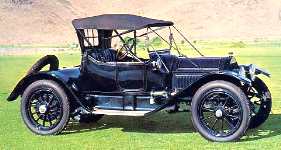
Surviving "Gentleman's Roadster",
from the former Harrah collection, Reno, NV
Trivia: from 3 August 1912 up to 25 April 1913, there were
175 Cadillac cars registered in Georgia [source: SAH Journal No. 149]. Queen
Liliuokalani of Hawaii once was driven in a 1913 Cadillac [photos in SAH,
#>>>, p.4]
1914
Facts: The last of the 4-cylinder Cadillac models. The
motor was rated 40HP. New, 2-speed direct-drive rear axle with electric control switch on
dash for engaging "high" or "low", low gear 3.66-1, for city driving,
high gear 2.5-1 for speeds around 16mph or more (the system was discontinued the following
year following a law-suit by Austin Auto Co. of Grand Rapids, Michigan who claimed it as
their own). New, hinged steering wheel for easier entrance and exit (front-seat passenger
may enter or leave car from either side); the gas tank was moved to the rear of the car
(previously it was mounted on the running board or under the front seat - as in 1913).
27000 Cadillac cars already equipped with electric starter and lights; specifications:
unchanged bore and stroke, enclosed valve mechanism, 40-50 HP (unchanged), new hot-water
jacketed carburetor to vaporize gasoline before engine is cranked in order to facilitate
cold-weather starting, gear ratio 3.66 to 1 and 2.5 to 1, drive shaft to two sets of bevel
gears (electric switch for rear axle gear control), wheel base and tread unchanged (see
1913), 6" (15.24cms) longer rear springs, fuel 20-gall., standard finish (all models)
Calumet green with gold stripe; standard equipment: Cadillac top, windshield, full lamp
equipment, gas gauge, electric horn, power tire pump, foot rail, robe rail and cocoa mat
in open car tonneaus, tire irons, set of tools including tire repair kit and Warner
autometer (this was an early type of drum-type speedomeeter and combined trip odometer,
operated by a flexible driving shaft from the car's front wheels).
Easy ID: side-light stanchions now level with top of hood;
smaller side lights; torpedo abandoned; roadster fenders are more curved all round; coupe
has larger windows all round; roof no longer projects over hood; no half-window at rear of
driver's compartment.
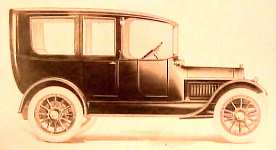
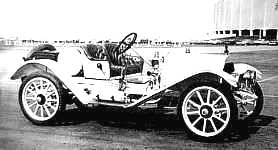
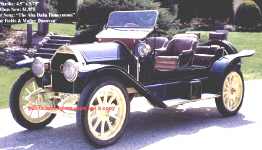
Models: "1914" Models on the 120" wheel
base: (1) 5-passenger Touring car ($1975). (2) 7-passenger Touring car
($2075). (3) Phaeton, ($1975). (4) Roadster ($1975); good photo &
story (CLCA 1987, pp.2-11). (5) (new) 3-passenger Landaulet Coupe ($2500).
(6) (new) inside-drive 5-passenger Limousine ($2800). (7) standard
7-passenger Limousine ($3250 and up), featured a center door, like the coupe; it
had a speaker tube, carriage lamps and privacy shades; there were no side windows in the
chauffeur compartment. Prices included top, windshield and demountable rims. Photo/
illustration: (CC 2/1977, p.21). Custom cars: "bus", in CLC,
2/74, "speedster" article (CC&CC 8/1967, cover, pp.12-17), details
including side view, front ensemble, drive train, headlights, rear axle, engine , steering
wheel, seats, exhaust, controls, clutch, steering mechanism, rear spares.
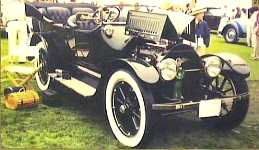
A nice surviving touring car
Trivia:
(1) The following information is drawn from the magazine Automotive
Industries which I was able to consult at the Detroit Public Library in September
1994. Stupidly, I forgot to note down the year/month: 1914 Cadillac wiring diagram,
p.190
(2) In two different 1914 ads, the Cadillac company recalled that
it had built more than 15,000 single cylinder models, or "one-lungers", and that
practically all of them were still in use, some having traveled more than 100,000 miles at
that writing. They admit also to having built a few cars with two, three and six
cylinder engines that were "as good as that type could possibly be made",
but that none had ever been marketed. What they did not say was that they were
secretly working on the first mass-produced V8 engine that for ever would revolutionize
the American motor car scene.
1915
Facts: Good write-up in AU, 17.9.14, pp.523-528 and
563. Introduction of first Cadillac L-head V-8 motor based on De Dion model [ad for first
De Dion V8 in French magazine ILL]; new Cadillac V8 model dubbed "The
sweetest running car in the world". "The ultimate in motor car
engines" was the verdict of the industry's representative engineers. High speed,
high efficiency, water-cooled eight-cylinder "V"-type engine with built-in
transmission, 3-point suspension. Two blocks of 4-cylinders. opposed at an angle of 90°
on a single aluminum-copper alloy 17/8"diameter heat-treated, chrome nickel alloy
crankshaft; specifications: bore and stroke 31/8 x 51/8" (80.6x131.4 mm); 314 cubic
inches displacement (5145.5 cu cms.), 31.25HP (S.A.E.) - actually more than 60, as shown
by dynamometer testing (rated at 70 BHP @ 2400 rpm); top speed was a conservative 55-65
mph; single, 5-bearing, silent, chain-driven camshaft; improved Cadillac Delco ignition,
dual system, supplied from generator and dry-cell battery; pressure-feed lubrication by
gear pump; Cadillac carburetor with air-control to facilitate starting; . All-new LH
steering [RH optional], gear change and brake lever set well forward in center of front
compartment with folding steering wheel allowing easy exit and entrance from either side
of car, switches for electric ignition and lights located on dash, cranking by pedal
button on floor, multiple-disc, dry-plate clutch (15 carbon-steel plates 7¾"diameter
196.85mm) alternate plates (fly-wheel driven) being coated with wire mesh asbestos;
selective type, sliding gear transmission with chrome nickel steel gears and shafts, 3
speeds forward and reverse; Cadillac Timken full-floating rear axles; drop-forged front
axle; tubular shaft drive with two universal joints, each enclosed in housing and running
in lubricant; one internal and one external expanding brakes directly on wheels with
17x2½" drums; adjustable worm and gear selector steering; 18" steering wheel
with corrugated walnut rim and aluminum spider; 6" deep, channel section, carbon
steel frame; 20-gallons fuel tank; wooden, artillery-type wheels with demountable rims for
straight-sided tires, tires U.S. or Goodrich 36x4½" (91.44x11.43cms) guaranteed by
their respective makers, 122" (309.88cms) wheel base (up 2", i.e. 5.08cms),
56" tread (optionally 61"); front semi-elliptic springs, rear three-quarter
platform; throttle and spark levels at steering wheel; hand-buffed black leather
upholstery over curled hair and coil springs; linoleum-covered, metal-bound running
boards; standard equipment includes "one-man" top with interior-operated
curtains, windshield, black-enameled and nickel-trimmed full lamp equipment, fuel gauge,
electric horn, power tire pump, foot rail, robe rail, license tag holders, tire irons,
locking toolbox, set of tools including tire repair kit, universal key fitting ignition,
light switch, toolbox and tire-holder lock, Warner auto-meter. Advertising for the first
Cadillac V8 was restrained; few cars were illustrated; text of ads was addressed to a
cultural and financial elite. The most famous of them all was Theodore McManus' "The
Penalty of Leadership".
Easy ID: Tool box storage door on body sill just behind
front fenders, otherwise bodies almost identical to 1914; 4-passenger phaeton omitted;
open cars have rounder, convex curve at lower, rear doors; windows of closed cars have
curved corners, compared to angular lines in 1914.
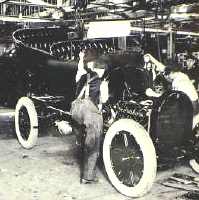
Dropping a touring car body onto a 1915 chassis
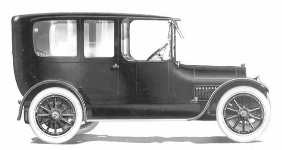
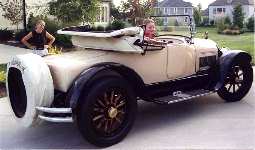
Left: 1915 limousine quarter window has curved upper
rear corner compared to 1914 version
Right: surviving V8 roadster
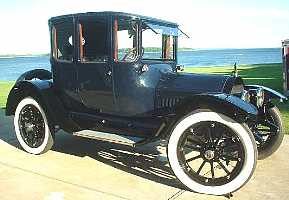
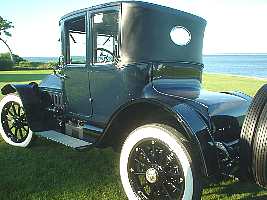
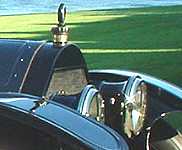

A beautifully restored landaulet coupe owned by Dick
Shappy, RI
Models: Type 51: ten bodies [two introduced late in the
year] including (1) standard 7-passenger standard touring car with 2 extra seats
folding into recess and concealed when not in use ($1975). (2) 5-passenger touring
car ($1975). (3) (new) 4-passenger Salon ($1975) - not illustrated in sales
brochure. (4) Roadster with collapsible rumble seat ($1975). (5)
3-passenger coupe ($2500). (6) (new) 5-passenger Sedan ($2800). (7)
7-passenger Limousine ($3450). (8) (new) 7-passenger Berline Limousine
($3600) - not shown in sales brochure. The two late models were: (9) 3-passenger
Victoria ($2400) and (10) 5-passenger brougham ($2950). All prices FOB Detroit.
There were few differences with the 4-cylinder models of the previous year).
Engine numbers: A-6000 to A-19001 [1914-1915]
Trivia: On August 29, 1915, a stock Cadillac V8
drove a distance of 72 miles in 77 minutes and beat by 12 minutes the express Vandalia
passenger train between Indianapolis and Terre-Haute, Indiana. On some stretches the car
reached a speed of 75 mph. Remember this is 1915 and the car is a stock Cadillac !
1916
Facts: Cadillac "Type 53". specifications: like
1915 cars but slightly taller hoods and bodies. Horsepower was increased to 77HP through
an enlarged intake manifold and a modified carburetor. Standard equipment included a
"one-man" top with interior-operated curtains, the so-called "Bishop
top"; also available was a new Waltham 8-day clock and inspection lamp. Options
included bumpers and spare tires. The annual brochure was printed by Peninsular Company,
Detroit.
Easy ID: Rounded radiator grille and engine hood with
raised beading on the top surface [see photos]; base of doors have even curve on either side (more marked at rear of doors on
1915 models); 5-passenger salon now has driver's door; new 3-passenger Victoria has blank
rear quarters; 5-passenger sedan become Brougham, gains four doors and loses trunk
"bump" at the rear; 7-passenger limousine loses coach lamps; 7-passenger
enclosed berline-limousine added, with narrow window between front and rear door glass.
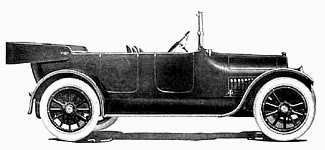
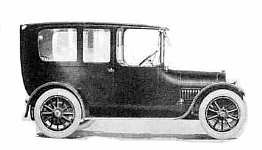
Models: Type 53: (1) standard 7-passenger car
($2080) (photo, also C&D card set). (2) 5-passenger touring car or Salon
($2080) (small photo). (3) 2-passenger Roadster (top speed: 65 mph) ($2080). (4)
3-passenger Victoria introduced late 1915, formal leather top, carriage bows, light
insert at top of door (in a lighter, contrasting color), small windows in the roof quarter
panels, front passenger seat set to the right and slightly back from the driver ($2400). (5)
4-passenger Coupe ($2800). (6) 5-passenger Brougham or standard sedan ($2950)
(photo). (7) 7-passenger open-front Limousine ($3450) (photo). (8) Berlin
(or berline) with fixed partition, black leather seat covering for driver, cloth and
mohair passenger area, two folding auxiliary seats ($3600) (photo). Other
photos/illustration: (CLCA 1980, p.28); instrument panel, (CLCA 1982, p.28);
7-passenger Touring car (CLCA 1982, p.29).
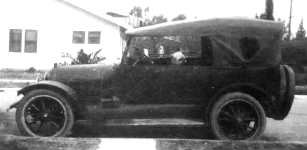
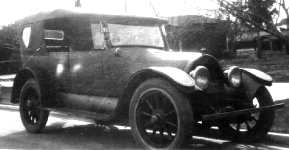
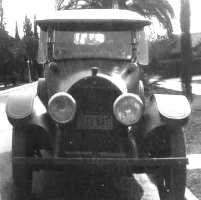
These pics likely were taken in the forties or
fifties
[ Source: Internet ]
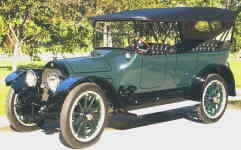
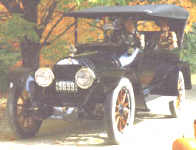
Engine numbers: A-20000 to A-38003
[1915-1916]
Trivia: On the eve of the Mexican campaign, i.e. in 1916,
the army owned five Cadillacs; these were assigned to the commanding generals at
Governor's Island, Fort Sam Houston and Hawaii. One was assigned also to the Chief of
Staff.
1917
Facts: Type 55, "Great War Cadillac"
story: (CLCA 1975, pp.15-17). Richard H. Collins becomes President and General
Manager. Benjamin H. Anibal takes over as chief engineer. Fenders became edged or
"crowned", some items got nickel-plating for the first time, headlights were
black-enameled, there was a 1½"wide belt molding on open cars. Frames were now
8" deep and had three cross-members. Wire wheels were optional. The Landaulet wheel
base increased by 3" (7.62cms) to 125" (317.5cms) and weighed 4035 lbs. There
were few mechanical changes: new, lighter pistons in "hour-glass" shape to
reduce bearing surface; 36x 4½" (91.44x11.43 cms) tires (smooth in front, anti-skid
in rear) In the height of summer, Henry M. Leland and son Wilfrid resigned from Cadillac
(though retaining financial interests) and entered aircraft engine production (Liberty
engine) following a dispute whether or not they should be built by Cadillac. After
undergoing grueling tests the standard Cadillac 7-passenger open car was picked as the
official staff car of the U.S. armed forces. Hundreds of them were shipped to Europe to
serve as military staff cars, ambulances, etc.
Easy ID: Similar to 1916 cars but no raised beading on top
portion off engine hood.

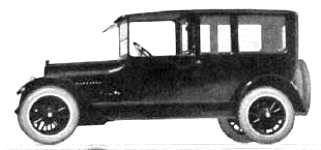
Left: 1917 Victoria. Right: Limousine
Models: eleven body styles were available [according to a
1917 Landaulet ad.]. Type 55 on 125" wheel base: (1) standard 7-passenger
Touring car with two folding auxiliary sears ($2080) (photo, also CLCA 1980, p.34),
(1a) same car but with full winter protection (side panels) also with two folding
auxiliary sears ($2675) (2) 4-5 passenger Phaeton ($2080), (3) 2-passenger
Roadster with rumble seat, handrails, squared rear panel ($2080) (photo), (4) 4-passenger
Club Roadster ($2080), (5) 5-passenger Brougham with two occasional seats ($2950)
(photo) , (6) 4-passenger convertible Victoria, the Cadillac "Vicky"
($2550) (photo), (7) 7-passenger convertible Touring Car ($.....), (8) 4-passenger
Coupe with vast expanses of glass (including the angled rear quarters) offering excellent
all-round vision ($2800) (photo), Type 55 on 125" wheel base: (9) 7-passenger
standard open-front Limousine with disappearing auxiliary sears, on 132" wheel base
($3600) (photo); (10) 7-passenger enclosed-drive limousine (Imperial) ($3750)
(photo); (11) 7-passenger Landaulet with collapsible rear quarters ($3750) (photo,
plus CLCA 1975 cover; story, p.1 - excellent color photo in French book "Histoire
de l'Automobile" [Atlas] p.168); (12) "stretched" 7-passenger
limousine with more glass area and slender pillars (photo).
Engine numbers: 55-A-1 to 55-S-2
[1916-1917]
Trivia 1: The
following information and trivia was drawn from the magazine Automotive Industries which I
was able to consult at the Detroit Public Library in September 1994. Stupidly, I forgot to
note down the year/month
- 1917 Cadillac Type 55, p.239
- Cadillac breaks record across Iowa, p.650
- Cadillac starts suit, p.955
Trivia 2: In
March 1917, Cadillac contacted the US Army, offering to supply special transport trucks
and automobiles, army trucks and airplane engines. Cadillac said it had also the
possibility of converting its auto body plant to build airplane fuselages.
1918-19
Facts: V8, Type 57; motors had removable cylinder heads
for easier servicing. A Kellogg tire-pump was now standard equipment (a most useful
"gadget" that would be of good use even on today's cars). D. McCall-White, the
Glaswegian engineer who had been instrumental in designing the first ever mass-produced V8
motor, left Cadillac to form the Lafayette Automobile Co. Body styles remained largely
unchanged from the "55" cars of the previous year. Radiators were taller, as
were motor hoods, which were also longer and sloped up into a modified cowl. notes (CLCA
30th anniversary issue, p.38); 31.25 HP (N.A.A.C. rating), Exide storage battery, 17-disc
clutch plate (up by two discs), tires 35x5" (88.9x12.7cms) at extra cost, except
2-passenger Roadster 34x4½" ( 91.44x11.43cms), wheel base up 3" (7.62cms) to
125" (317.5cms) (except Limousine, Imperial, Landaulet, town Limousine, town Land and
7-passenger Suburban, all 10" (25.4cms) more than last year at 132" (335.28cms),
tread 56" (142.24cms) only, 20-gallons fuel tank all models. "one-man" top,
gypsy-type rear curtains with bevel plate glass window in rear, fully-lined top, more than
¾ transparent area in side curtains, brackets quickly attached without screws, bolts or
tools allow side curtains to open/close with doors, dust envelope (top boot) for top. Full
lamp equipment, tilting headlamps controlled by lever on steering column, lighted 8-day
clock, speedometer (legible from tonneau), tire carrier for 2 tires, smaller tools in
convenient pocket kit in lower part of LH front door (open body types), rest like 1917.
Upholstering of open cars: English long-grain hand-buffed black leather laid in plaits;
enclosed cars: variety of high quality selected cloths.
Easy ID: Lower doors are square-cornered instead of
rounded [except rear curve of rear door on landaulet]. Largely unchanged from Type 55
cars; radiators were taller, as were the motor hoods which were also longer and sloped
into a modified cowl.
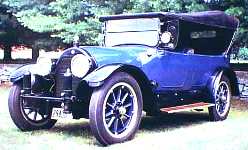
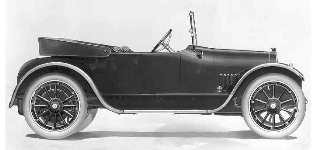
1918 touring car (left) and roadster (right)

A 1918 tourer ...back in the day
Models: Twelve different bodies (only ten shown in SEP
ad); Type 57 models on 125" wheel base: (1) 7-passenger car ($2085) (photo,
plus story and photos in CLCA 30th anniversary issue. pp.9-10). (2)
4-passenger Phaeton with room for five ($2085) (photo) (3) 2-passenger Roadster
with rumble seat for 2 extra passenger ($2085). (4) 4-passenger Convertible
Victoria ($3205) (color photo); (5) 5-passenger Brougham ($3650) (photo). Type 57
on 132" wheel base: (6) (new - late-year addition) 7-passenger Suburban. (7)
4-passenger Limousine ($4160) (photo, narrow window at rear of front compartment). (8)
new 7-passenger Imperial limousine with open front ($4345) (photo). (9) new
7-passenger Landaulet (photo, open rear); ($4295-4310) (photo). (10) (new)
7-passenger Limousine or Town Limousine with open front ($4160) (photo). (11) (new)
7-passenger Town Landaulet, shorter body, open front ($4310) (photo - open rear). (12)
(???)
Engine numbers: 57-A-1 to 57-TT-150
[1917-1918 and 1919]
1919
Facts: V8, Type 57; like 1918, speedometer with trip
reset, ammeter, lighted gas and oil pressure gauges, tools including pliers, cold chisel,
large & small screwdrivers, bicycle wrench, monkey wrench, octagonal punch, spark plug
and gasket, hammer, brace & socket wrench for demountable rims, auto jack and handle,
set screw wrench generator shaft, handy lamp, starting crank, spark plug and air-cock
wrench, wrench for outside brake adjustment, plain distributor wrench, same with gauges,
hub cap wrench, water pump wrench, oil gun, hose and gauge for tire pump, instrument
manual, oiling chart; 125" wheel base (317.5cms) except Suburban and Limousine, tires
35x5" (88.9x12.7cms) (except Roadster 34x4½" (91.44x11.43 cms); finish on open
cars: Cadillac blue with black trimmings and black chassis for all open cars, cream wheels
on Roadster; finish on closed cars: Calumet green trimmed with black on upper work,
radiator, fenders, dust shields and hub caps, black chassis, special colors on all bodies
at extra charge; upholstering in closed cars is rich striped mohair velvet in neutral
tones harmonizing with other colors, laid in French plaits over seat cushions, arm rests,
and sides below arm rests; doors , ceilings and all upper work plain headlining to match
lighter background of striped material; auxiliary seats are plain material; bindings are
blind tacked of same material; ebony-finished window sashes and casings. Cadillac returned
to more subdued advertising themes; there were few illustrations of actual models,
especially in the latter part of the period 1918-1919. The trend in late 1919 was to
depict "family"-type situations, like mum and the kids, grandma and John back
from the war. It was the birth of a new form of people-oriented ads. A book published by
the company just after the end of the war recounts the company's participation in the
first world war.
Easy ID: Hood louvers now more closely spaced.
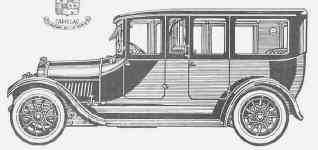
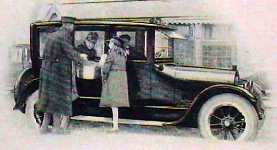
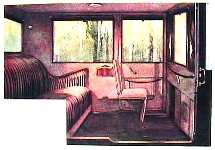
1919 Limousine and its interior [from that year's
product brochure]
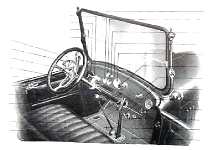
The driving position
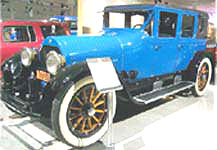
A survivor [2007]
Models: Continuation of Type 57 for second year. (1)
7-passenger car (photo). (2) 4-passenger Phaeton; (3) 2-passenger Roadster
(photo). (4) 4-passenger Convertible Victoria; (5) 5-passenger Brougham
(photo). Type 57 on 132" wheel base: (6) 7-passenger Suburban. (7)
4-passenger Limousine. (8) 7-passenger Imperial limousine with open front. (9) 7-passenger
Landaulet. (10) 7-passenger Limousine or Town Limousine with open front. (11)
7-passenger Town Landaulet. (12) (???); custom model by Brewster, CLCA 1975,
p.29; also CLCA 1977, p.42; same after restoration [???], CLCA 1987, p.34;
Touring car, CLCA 1981, p.26; good photo with General Pershing in catalog "From
Peace to War" [1943-44], type 57 landaulet (CCI, 26:2)

1919 Sedan for 7 passengers
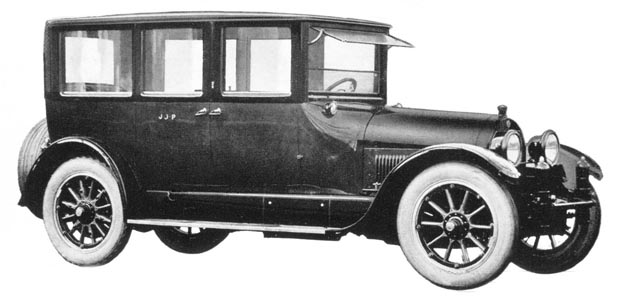
This 1919 Limousine was a gift from
the Cadillac Motor Car Co. to General J.J. Pershing
for his efforts to restore peace in Europe during the 1914-18 world
conflict
Engine numbers: 57-A-1 to 57-TT-150
[see 1917-1918, above]
Trivia: The following
information and trivia was drawn from the magazine Automotive Industries which I was able
to consult at the Detroit Public Library in September 1994. Stupidly, I forgot to note
down the year/month.
- Cadillac's welfare Department, p.350
- Cadillac prices $160 higher, p. 991
- Cadillac invests $2,000,000 in plant, p.833
1920
Facts: V8, Type 59; no major changes from previous
year; HP increased slightly to 79HP; prices ranged from $3590 (2-passenger Roadster) to
$5190 (7-passenger Imperial - the highest priced Cadillac to date); M for April
1920 [p.71] reported African trip by 3 adventurous types who drove from Johannesburg to
Lourenço Marques and back, paying visit to heavy-weight queen of Swaziland (circa 300
lbs) on the way and driving her in the Cadillac {***}.
Easy ID: Decorated headlight doors shaped like the
Cadillac crest, with small crest at the top, in the center.
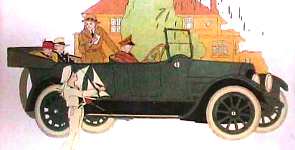
Models: (1) 7-passenger open car (photo, plus CLCA
1987, p.35; side view, CLCA 1974, p.25 and CS11, p.48); (2)
5-passenger open car (photo); (3) rumble-seat Roadster (photo); (4) Victoria
(photo); (5) 5-passenger Sedan (photo); (6) Standard limousine (photo); (7)
7-passenger Suburban (photo); (8) 7-passenger Imperial limousine (photo); [others
>>>>>]. New Type 59: custom body by Don Lee, CLCA 1978, p.12; Sport
Phaeton, rear view, CLCA 1985, p.30; Coupe photo, CLCA 1979, p.34; Don Lee
Touring Sedan, in book "Automobile and Culture" p.222 (HW collection) {***};
custom body by Nordberg in Nordberg body book, has "Mercedes"-like pointed
"V" grille [Nordberg did others like it, e.g. Hudson, Minerva, Mercedes] {***}
[Nordberg coachcraft book sold 1992 to Olivier Delafon].
Engine numbers: 59-A-1 to 59-BB-12
[1920-1921]
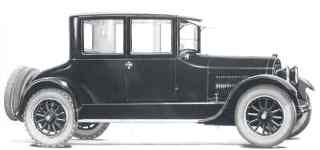
This is the Victoria Coupe for 1920
1921
Facts: V8, Type 59; like 1920. Vast new Cadillac plant (49
acre site with 2,500,000 sq. ft of premises) opened in Detroit, replacing former 77
buildings. Principal manufacturing premises had 970,000 sq.ft.; new mass-production
methods began; raw materials entered at one end, completed chassis came out at the other
end; continuous conveyer shuttled parts into paint dip tank and 3 baking ovens; Cadillac
employed 6000 people.
Easy ID: basically unchanged from 1920
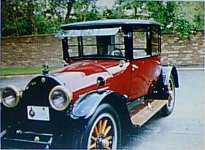
The touring sedan
Models: >>>>> the Coupe and Town Brougham
(which sold for $5090) were dropped from the line in 1921. (1) 7-passenger touring
car (photo, plus CLCA 1985, p.25 and in color CC&CC 2/1985, p.11); (2)
Victoria (photo); (3) 5-passenger Sedan (photo); (4) 7-passenger Limousine
(photo in Japanese catalog for 1987 cars, p.17); [others >>>>>].
Engine numbers: 59-A-1 to 59-BB-12
[1920-1921]
Trivia: 1) Two Cadillacs
participated in the Monaco Concours d'Elegance in 1921: a sedan and a touring car.
Trivia: 2) I saw for sale on
the Internet in 1999 an interesting invoice relating to the trade-in of a 1921 Cadillac
Type 59 Victoria for a new 1922 Type 21 model (also a Victoria body style). The
new car cost $4186.90; it was equipped with Cord tube tires, weed
tire chains, a Lyons front bumper and Boyce motometer. The allowance for the Type 59 was
$1936. Only a nut like me is fascinated to note that 1922 Type 61 engine serial
#61-Z-505 was fitted with a Victoria coupe body!